Your outdoor signs for business take a real beating. Sometimes it is 30°C+ and blazing sun. Sometimes it’s pouring rain or freezing cold. If you run a business in Australia, your outdoor signs are exposed to a lot of UV rays, wind, rain, salt, frost, and whatever is possible.
That’s why weatherproof outdoor signs are not luxury; they are essential. To weatherproof your outdoor signs, you can implement multiple strategies like:
- Choosing the weather-resistant materials
- Protecting the signs from the sun, rain, and wind
- Watching out for frost and freeze damage
- Cleaning the signs regularly
- Following a seasonal cleaning checklist
In this guide, you’ll learn how to protect your signs from the elements—step by step. From choosing the right materials to cleaning and maintaining them through every season, these strategies will help your signage last longer and look better.

Why You Need Weatherproof Outdoor Signs
Australia’s weather is wild. Your outdoor signs will experience harsh sun, coastal winds, flash storms, salty air, and more.
Over time, your signs can face damage, including:
- Colour fading
- Crack or warp materials
- Loosen mounts
- Destroy adhesive
- Water damage, and more.
And once a sign starts to peel or rust, it indicates that you are not caring about your business and customers.
Your targeted customers receive misleading messages, which can lead to losing your investment in sign marketing and real business opportunities.
So, if you want your investment to last, you need outdoor sign durability and solid seasonal care.
6 Smart Strategies to Weatherproof Outdoor Signs
Here we have discussed 6 effective strategies to weatherproof your outdoor signs so that they can keep up their integrity for a long time.
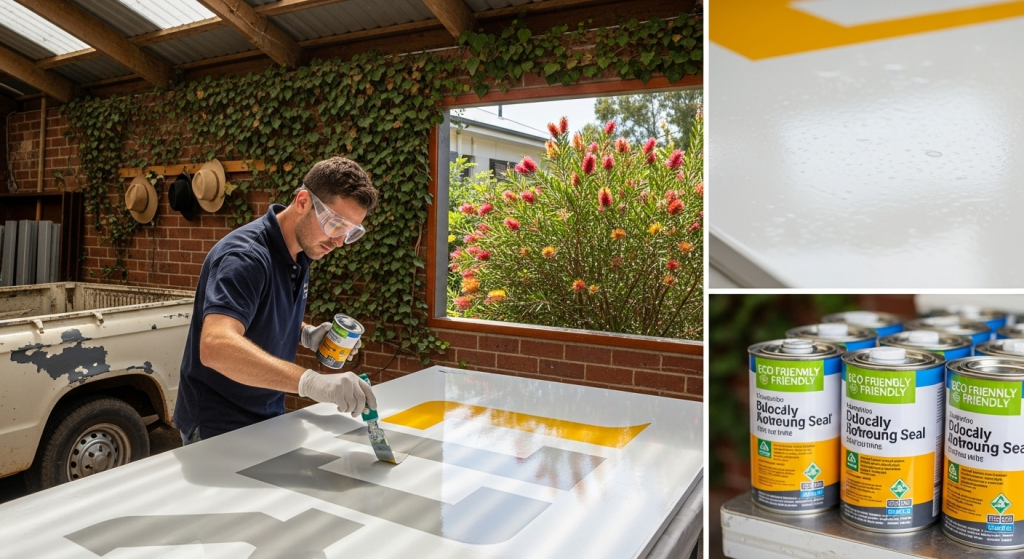
1. Start with the Right Weather-Resistant Materials
Your first arsenal to fight the diverse weather of Australia is to choose the right weather-resistant materials for your signs. So, when you choose the right materials for your outdoor signs, it is mainly done against harsh weather, and your signs are set to be dominant for years.
Here are the most durable weather-resistant materials you should choose to weatherproof outdoor signs for your business.
- Aluminium
Aluminium is highly corrosion- and UV-resistant. Aluminium can reflect 80% UV light, which can reach more than 90% for AL.2.
This also corrodes at a very low rate, ranging from 0.03 to 4 µm every year.
The rust-proof and UV-proof features make aluminium a great choice to ensure your outdoor signs stay weatherproof for many years.
- Stainless Steel (SS)
SS is another great material to keep your outdoor signs weatherproof. SS contains 10.5 to 30% high chromium content, making it highly resistant to corrosion.
It is strong and becomes water-resistant with proper powder coating. With its heaviness, it can easily withstand winds and storms.
- Cast Vinyl
If you are thinking of installing outdoor wraps on glass, walls, vehicles, or metal surfaces, go for cast vinyl. Cast vinyl is considered a highly premium segment of material for outdoor signs.
It is one of the most flexible sign materials and deserves its own spotlight.
Cast vinyl is waterproof and UV-resistant, and can achieve more toughness and durability when laminated.
Cast vinyl is perfect for weatherproof outdoor signs on shop windows, delivery vans, or sandwich boards.
Pair vinyl with proper laminates or protective coatings, and it’ll stick around for years without peeling or fading.
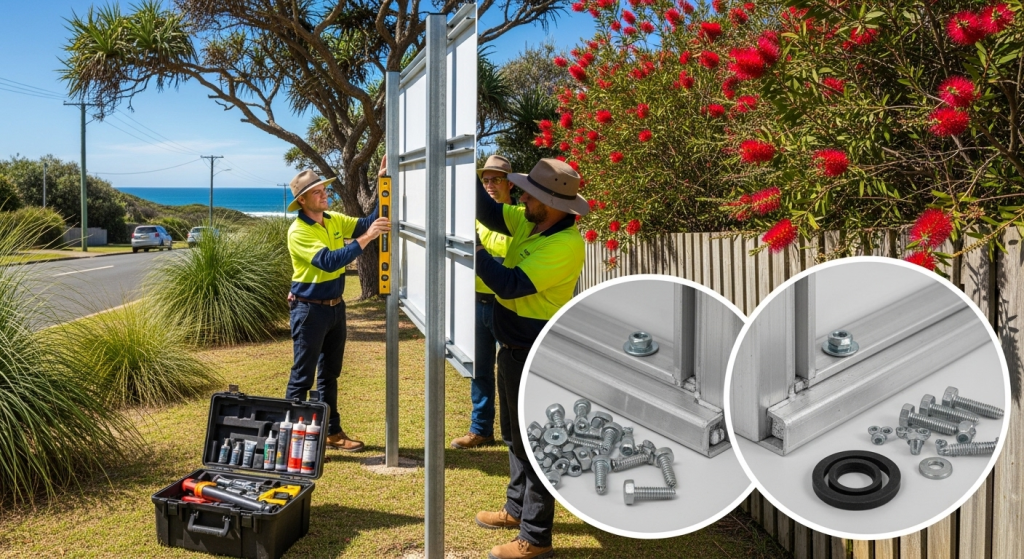
2. Ensure Secure Installation for Wind and Weather
Strong winds are no joke, and Australia experiences severe storms, winds, cyclones, etc. A poorly mounted sign can rattle, bend, or even fly off.
So, install your signs using proper wind-resistant sign installation methods.
- Use anti-corrosion sign hardware, especially for bolts and frames. Stainless steel bolts, galvanised brackets, stainless steel frames and rust-proof mounting plates that won’t weaken in coastal air or storms are the go-to choice.
- Anchoring into brick or concrete (not just wood)
- Spacing signs away from the wall to let wind pass through (especially large panels)
For freestanding signs, make sure the base is heavy enough to withstand gusts. And check the bolts seasonally—loose hardware is a big problem during storms.
Use–
- Temperature-resistant adhesives: Cheap glues fail in the heat or cold. Use commercial-grade adhesives that are designed for outdoor use. They stay strong in summer heat and don’t crack in winter.
- Outdoor sign weather seals: These are seals, gaskets, or silicone borders added during installation. They prevent water, dust, and wind from getting into joints, corners, or behind panels. So, don’t forget to use them.

3. Protect Your Signs from Sun, Rain, and Moisture
Sun and water are brutal on outdoor signage. Together, they’re the top reason signs fade, peel, or fall apart. If you’re not careful after installing your outdoor signs and just leave them as they are, your sign will look old long before it should.
Let’s make sure that doesn’t happen.
- Start with UV protection signage laminates made from polyester (PET) or PVC vinyl with built-in UV inhibitors. These simple sun fade prevention layers act like sunglasses for your signs, blocking UVA and UVB rays that cause colours to fade and vinyl to become brittle.
- You can also use UV overlaminates with acrylic adhesives, which are widely used in commercial signage for their clarity and durability.
- Another option is applying clear topcoats made from urethane or acrylic polymers. These are liquid coatings brushed or sprayed over the surfaces of your outdoor signs to create a protective, glossy shield.
- These are ideal for sun fade prevention. They not only improve colour but also add chemical and scratch resistance. Together, these treatments preserve your reds, yellows, and blues—so they stay bold, bright, and visible even under intense sun.
- Next, apply waterproof sign coatings. These include UV-protective varnishes, acrylic sealants, and urethane top coats. They form a protective barrier that locks out moisture and sunlight at the same time.
- Want extra moisture resistance? Look into rainproof outdoor signage upgrades. Some materials are better suited for wet conditions, like aluminium composite panels or marine-grade vinyl. You can even apply hydrophobic films that make rain bead up and slide right off the surface.
- And don’t skip the sign edge sealing techniques. Most water damage doesn’t come from the surface—it seeps in through the sides. That’s why sealing edges, seams, and screw holes with clear silicone or weatherproof tape is a must. This is especially important on layered signs or 3D letters.
- The goal here isn’t just to stop on one rainy day or one hot afternoon. It’s to build a system of protection that keeps your sign looking fresh, dry, and professional through every season.
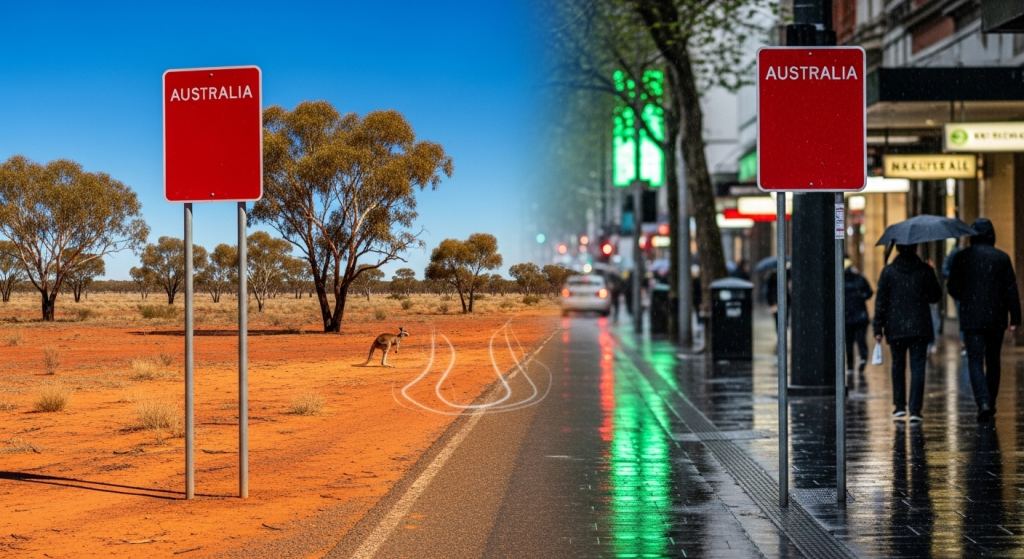
4. Watch Out for Frost and Freeze Damage
Even if you’re not in the snowy parts of Australia, cold weather during the winter can cause damage. Materials expand and contract in winter. Water freezes inside cracks and lifts the coating.
To avoid this:
- Use frost and freeze protection solutions like insulated backings
- Add rubber spacers to allow for expansion
- Avoid hard plastics that turn brittle in cold
- Use adhesives rated for sub-zero conditions. Choose acrylic or polyurethane adhesives for structural bonding, and silicone for edge sealing and flexibility. These materials remain stable and reliable even when temperatures drop sharply or fluctuate.
The goal is to make sure your all-season sign design holds up whether it’s +40°C or –2°C.
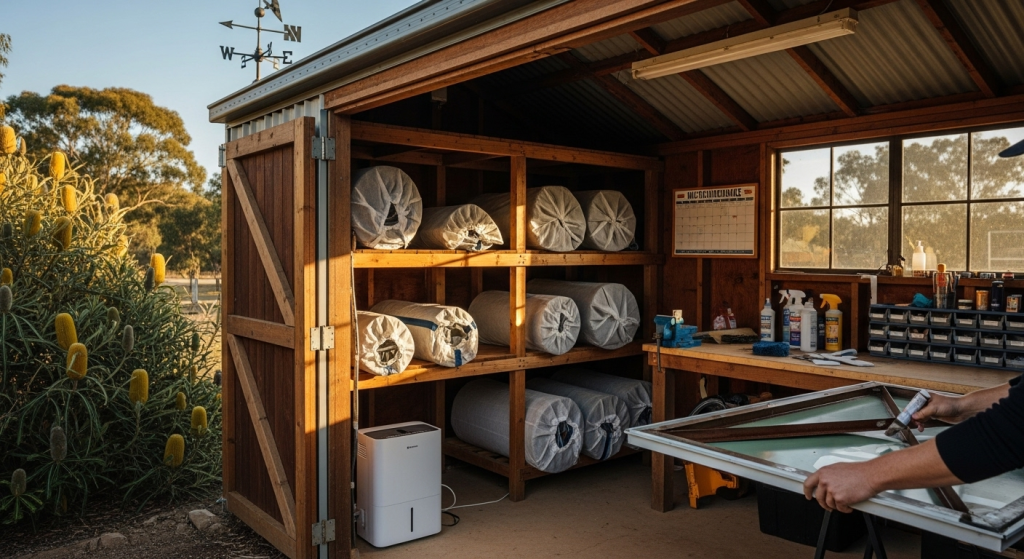
5. Keep Signs Clean and Looking Sharp
Even the best-made signs will look old, cracked, or warped if you don’t regularly maintain them.
Set a routine for exterior sign cleaning and restoration.
Here’s a simple plan with basic sign maintenance tips.
- Once a month: Wipe down your outdoor signs with mild detergent and a soft cloth. Avoid abrasive sponges or pressure washers—they can damage coatings.
- Every 6 months: Reapply waterproof coatings and reseal edges.
- Annually: Inspect mounts, frames, and corners for wear.
Need more life from old signage? Use restoration techniques like re-laminating or polishing. It’s less expensive than a full replacement and makes a significant difference.
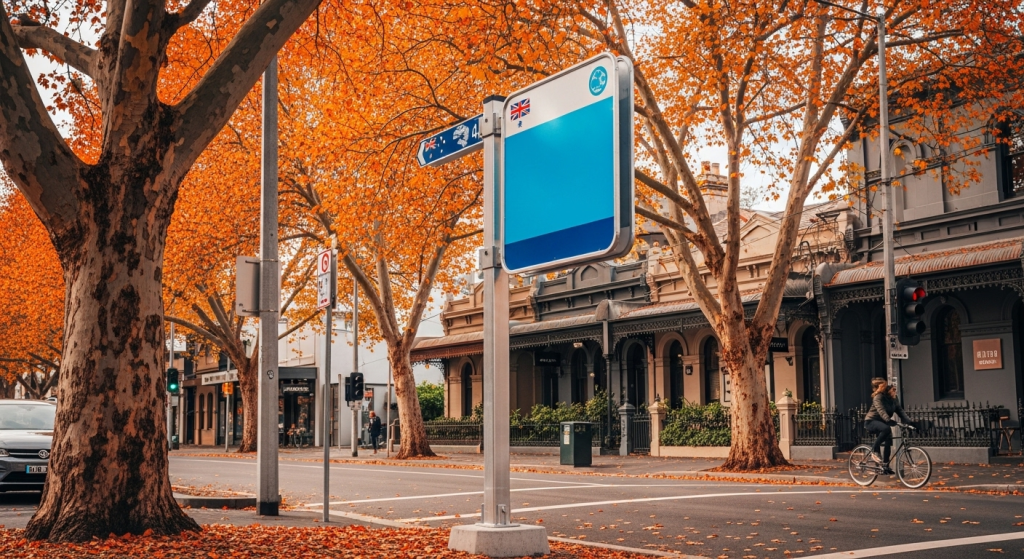
6. You Should Follow a Seasonal Signs Care Checklist to Keep Them Weatherproof
Each season brings different threats to your outdoor signage. Follow the checklist below to protect your signage throughout the year.
1. Summer
- Check for fading
- Reapply UV protection signage film
- Tighten loose fittings (heat expands materials)
2. Autumn
- Remove leaf buildup
- Clean mounts and edges
- Prepare for rain and wind
3. Winter
- Inspect for cracks
- Use frost and freeze protection where needed
- Make sure seals are intact
4. Spring
- Deep clean and rinse off pollen
- Repaint or polish faded sections
- Inspect for rust and reseal
This type of seasonal sign care only requires a few hours a year, but it extends the life of your signage by years.

FAQs
Aluminium and acrylic are your best options. They don’t rust, resist fading, and withstand extreme weather well, especially when laminated with UV-protected signage film.
At least once a month, or more if you’re near a highway, factory, or the coast. Always use non-abrasive cloths and avoid harsh cleaners.
If the sign is structurally sound but faded or water-stained, recoating it with waterproof sign coatings or UV laminates can significantly extend its life. It’s a cost-effective alternative to full replacement, especially for large or mounted signs.
Apply sun fade prevention coatings or UV-blocking films. These reduce damage from direct sunlight and keep colours looking new.
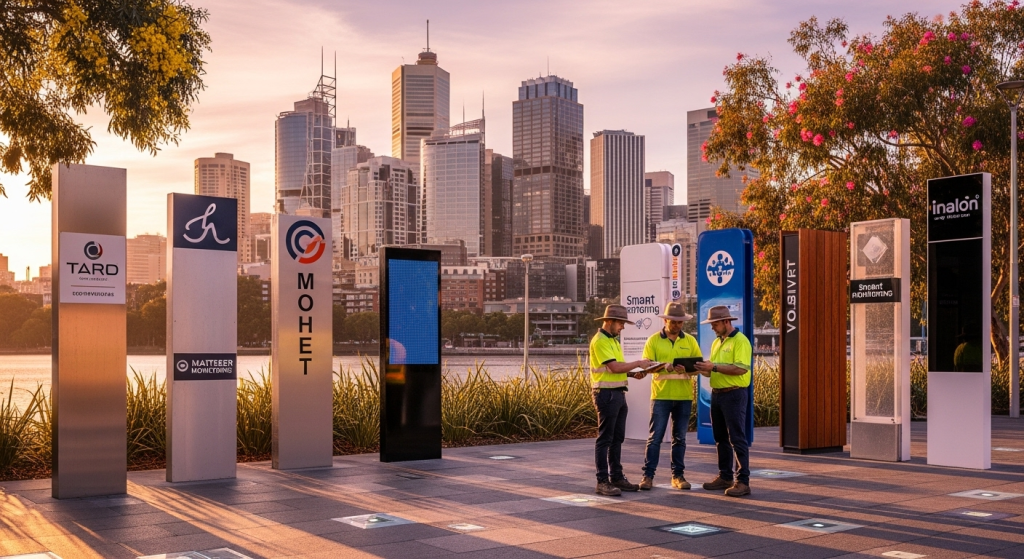
Final Thought
If you’re investing in weatherproof outdoor signs, protecting them with smart seasonal strategies makes all the difference. From choosing the right materials to sealing edges and fighting UV fade, proper maintenance ensures your signage stays sharp and professional all year round.
At Signage 4Business Group, we do more than just basic install signs. We offer custom signage design, expert installation, and durable finishes that can handle Australia’s climate. Whether you need a sign that survives the heat, wind, or rain, or you need to weatherproof old signs, we’ll help you create something built to last—stylish, strong, and always on brand.